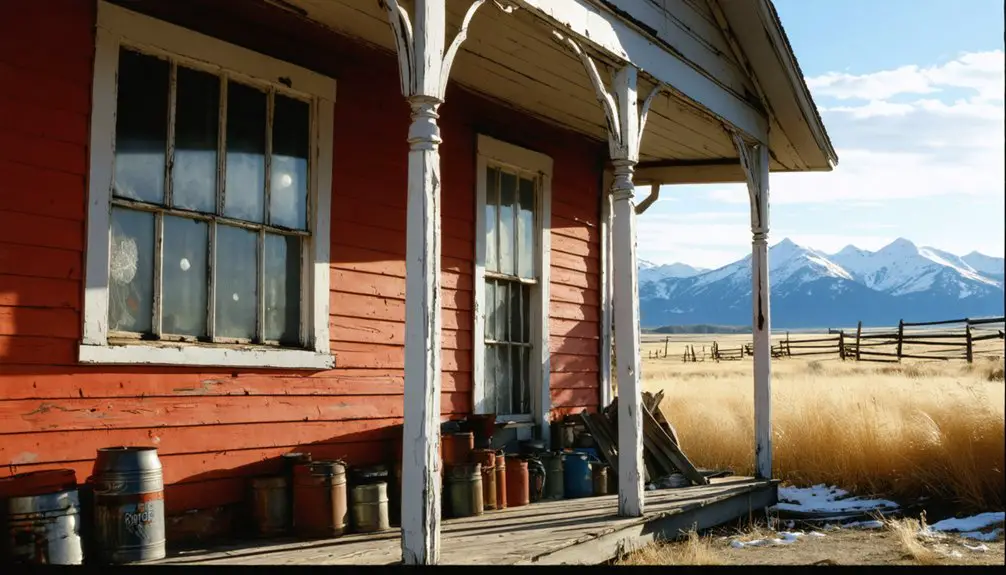You’ll find Washoe, Montana‘s remnants in Carbon County, where Anaconda Copper Company established this company town in 1906. With a peak population of 950, Washoe thrived on coal production, supported by the Northern Pacific Railroad connection to Bridger. The devastating Smith Mine disaster of 1943 marked the beginning of its decline, claiming 74 lives. Today, the historic Washoe Theater stands as an architectural gem, hinting at the town’s complex story of industrial power and human resilience.
Key Takeaways
- Washoe was established in 1906 by Anaconda Copper Company as a coal mining town, reaching a peak population of 950 residents.
- The community operated as a company town with residents dependent on Anaconda Copper for housing, employment, and basic services.
- The devastating Smith Mine disaster of 1943 killed 74 miners, marking a significant turning point in the town’s decline.
- The Northern Pacific Railroad connection through Washoe played a crucial role in the town’s growth and coal transportation operations.
- The historic Washoe Theater remains as a preserved architectural landmark, representing the town’s prosperous mining-era heritage.
The Birth of a Mining Town
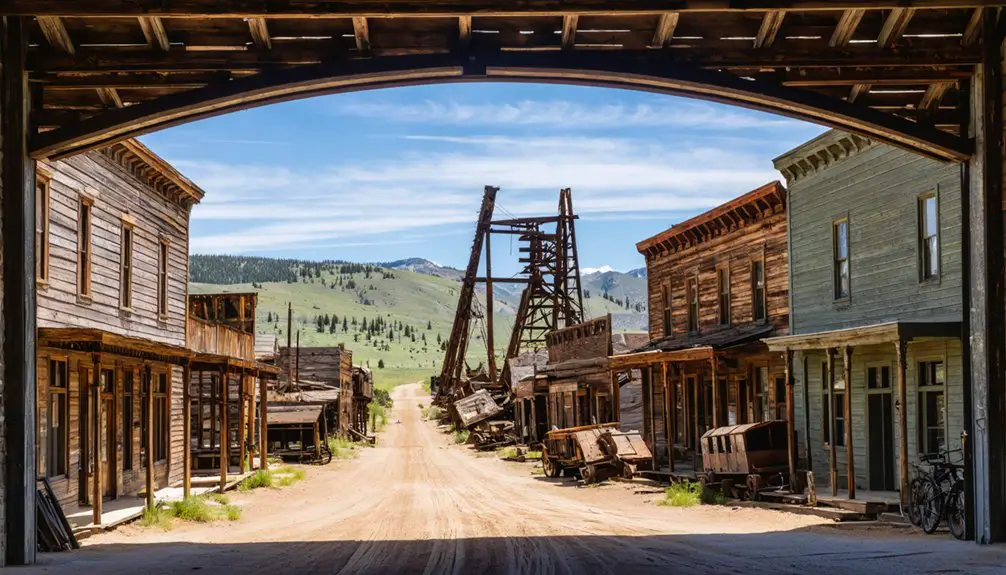
In 1903, Fred and Annie Bartels acquired a plot of land in Carbon County, Montana, that would soon transform into the bustling mining town of Washoe. The area’s rich coal deposits had already put Carbon County on the map when it formed in 1895, attracting the attention of early settlers and industrial giants alike.
You’ll find that everything changed in 1906 when the Anaconda Copper Company purchased the land near the Beartooth Mountains and Bearcreek River headwaters. They quickly established Washoe, naming it after a Nevada Indian tribe, and set up a post office by 1907.
The community dynamics took shape as the population swelled to 950, with the Northern Pacific Railroad connecting the town to the outside world. Daily coal shipments of 1,200 tons made Washoe an essential hub for Anaconda’s smelting operations.
Life Under Anaconda Copper’s Shadow
If you’d worked in Washoe during Anaconda Copper’s reign, you’d have found yourself living in company housing, shopping at the company store, and participating in company-sanctioned social activities.
Your entire existence would’ve revolved around Anaconda’s coal mining operations, which extracted up to 1,200 tons daily to feed the corporation’s massive smelting needs.
The company’s tight control over workers’ lives typified the harsh realities of early 20th-century company towns, where corporate profits consistently outweighed individual workers’ wellbeing. The mining giant’s power grew substantially after a 1895 reorganization as Anaconda Copper Mining Company, which established a $30 million capitalization and absorbed numerous subsidiary operations.
Company Control Over Workers
While many mining companies exerted control over their workers, Anaconda Copper Mining Company‘s grip on its workforce reached unprecedented levels through an intricate system of economic, social, and infrastructural dominance. You’d find their control extended far beyond wage negotiations, encompassing every aspect of daily life in company towns like Washoe. Through collective bargaining, they’d manipulate contract terms while maintaining ultimate power over employment conditions.
Yet worker solidarity emerged as a powerful counterforce. You’ll recognize this resistance in the 1934 strike and decades of sustained union organization.
Despite the company’s “copper collar” control over housing, transportation, and social venues, workers maintained their collective identity. They’d face challenges from competing unions and anti-labor pressures, but their shared activism and communal values persisted against Anaconda’s pervasive influence.
Mining Profits Above People
Anaconda Copper Mining Company’s relentless pursuit of profits shaped every aspect of life in Washoe, extending far beyond their control over workers’ daily activities.
You’d find stark evidence of corporate greed in their prioritization of ore processing capacity over labor conditions, and their drive to maximize shareholder value while neglecting worker welfare.
As mining costs rose and ore quality declined, you’d witness increased worker exploitation through aggressive extraction techniques and exposure to toxic compounds.
The company’s construction of massive smokestacks at the Washoe Smelter exemplified their disregard for community health, while technological “improvements” like block-caving and open-pit mining served profit margins rather than safety.
Even as mechanization advanced, the physical toll on workers remained severe, revealing how Anaconda’s financial interests consistently trumped human considerations until the operation’s final closure.
The Montana, Wyoming & Southern Railway Impact
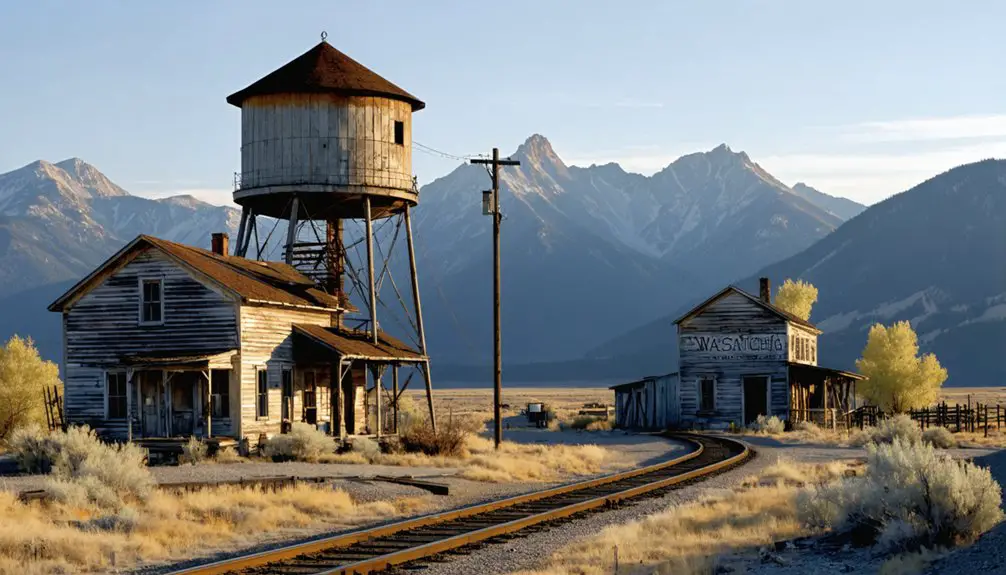
You’ll find that Washoe’s economic fortunes changed dramatically with the arrival of the Montana Wyoming & Southern Railway in 1906, connecting the town to Bridger and the broader Northern Pacific network.
The railway’s construction spurred rapid growth in coal mining operations, transforming Washoe into a bustling transportation hub for high-grade coal shipments throughout the region. Unfortunately, like other rail ventures of the era, the line faced major difficulties moving freight efficiently due to insufficient ballast in clay-rich soil.
Your understanding of Washoe’s peak years must consider how the MW&S Railway created essential links between local mines, processing facilities, and national markets, enabling the town’s brief but prosperous industrial period.
Railway Construction Timeline
The Montana, Wyoming & Southern Railway‘s construction marked a significant period of regional development when crews began laying 60 lb/yard relay rail in 1905.
Railway engineering advancements helped crews navigate the rugged terrain of southeastern Montana and northern Wyoming, though historical railway challenges persisted throughout the project.
You’ll find the most intensive construction period occurred in the early 1920s, with major earthworks beginning near Miles City on April 2, 1923.
Survey teams mapped the Casper to Miles City route, while construction crews worked simultaneously at multiple points to speed up completion, similar to how the three miles daily progress was achieved during the Great Northern Railroad’s construction.
The project relied on Chinese laborers who performed much of the difficult manual labor required for the railway’s construction, following practices established during earlier transcontinental projects.
By the mid-1920s, the railway had established crucial connections between resource-rich areas and larger rail networks, though financial pressures began mounting.
The line’s 72,000-ton freight volume in 1926 reflected the region’s industrial growth, despite declining revenues.
Economic Growth Through Rail
While Montana’s early economy relied heavily on horse-drawn wagons, the Montana, Wyoming & Southern Railway revolutionized regional commerce by slashing transportation costs and expanding market reach for local producers.
Much like the Union Pacific Railroad, the railway system transformed transportation and boosted economic development across the region.
You’ll find that railway expansion transformed isolated settlements into thriving communities, particularly in Montana’s Golden Triangle where wheat production boomed. The rail system didn’t just serve agriculture – it fostered economic diversification by supporting both farming and mining operations.
The railway’s impact reached beyond basic transportation. It created jobs, boosted tax revenues, and integrated local markets into national distribution networks.
You could see the transformation as communities along the route developed permanent settlements, replacing temporary wagon-trail stops. This infrastructure investment ultimately shaped Montana’s territorial growth and economic identity for generations to come.
Transportation Network Development
Established in 1906 as the Yellowstone Park Railroad, the Montana, Wyoming & Southern Railway transformed regional transportation by constructing an essential 23-mile route from Bridger to Washoe, Montana.
This transportation innovation connected previously isolated mining communities to the national rail network through its junction with the Northern Pacific Railway at Bridger.
You’ll find the MW&S’s strategic development included a branch line to Eagle and the establishment of Belfry as its headquarters at Bear Creek’s mouth.
While the rail industry giant Northern Pacific declined to purchase MW&S, they maintained a significant partnership, providing coal cars and infrastructure support.
This relationship, though limiting MW&S’s expansion options, guaranteed steady coal transport operations.
The railroad became vital for transporting coal from Montana Coal and Iron Company operations until its closure in 1953.
The railroad’s independent status didn’t prevent it from becoming the region’s critical transportation lifeline until its closure in 1953.
The arrival of the MW&S railway between 1904 and 1909 enabled the opening of several Bear Creek mines, spurring significant industrial growth in the area.
The Tragic Smith Mine Disaster of 1943
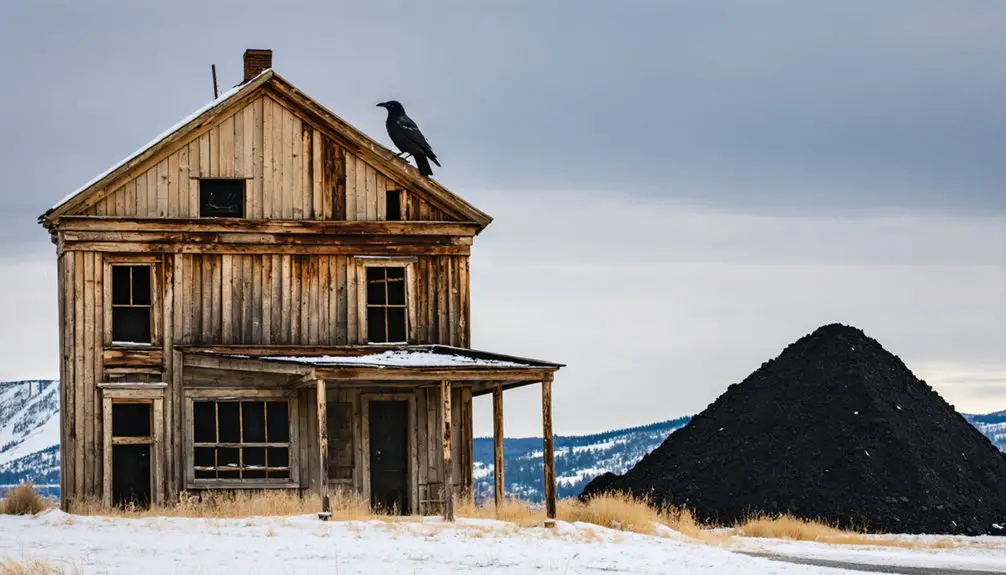
On February 27, 1943, a catastrophic explosion rocked Smith Mine No. 3 near Washoe, Montana, claiming 74 miners’ lives in what would become the state’s deadliest mining disaster. The blast, likely triggered by methane gas igniting from an open flame, occurred at 9:37 a.m. while 77 men worked underground. Only three miners survived.
Despite the mine’s known safety regulation violations, including inadequate rock dusting and the continued use of dangerous carbide lamps, operations had continued.
Safety violations were well documented at Smith Mine, yet operations persisted despite clear dangers to miners’ lives.
Rescue efforts proved extremely challenging due to toxic gases and heavy smoke, with one rescuer losing his life during the attempt.
The tragedy devastated Washoe’s community resilience, leaving numerous families without breadwinners and forever altering the town’s social fabric.
Today, the disaster serves as a sobering reminder of industrial risks and the human cost of inadequate mining safety measures.
Daily Life in a Company-Owned Community
Before the devastating 1943 mine disaster, Washoe embodied the classic model of a company-owned mining town, where the Anaconda Copper Company controlled every aspect of residents’ lives.
You’d find yourself living in company housing along “Company Row,” shopping at the company store, and watching your children attend the company-run school system.
The company dynamics created a complex web of dependence, with your daily routine revolving around coal production that shipped 1,200 tons daily via the Northern Pacific Railroad.
While the community hall and post office served as gathering spots fostering worker solidarity, you couldn’t escape the corporation’s watchful eye.
From the air you breathed – tainted by smelter emissions – to the goods you could purchase, Anaconda’s influence shaped every facet of your existence in this isolated but structured mining community.
The Washoe Theater’s Art Deco Legacy
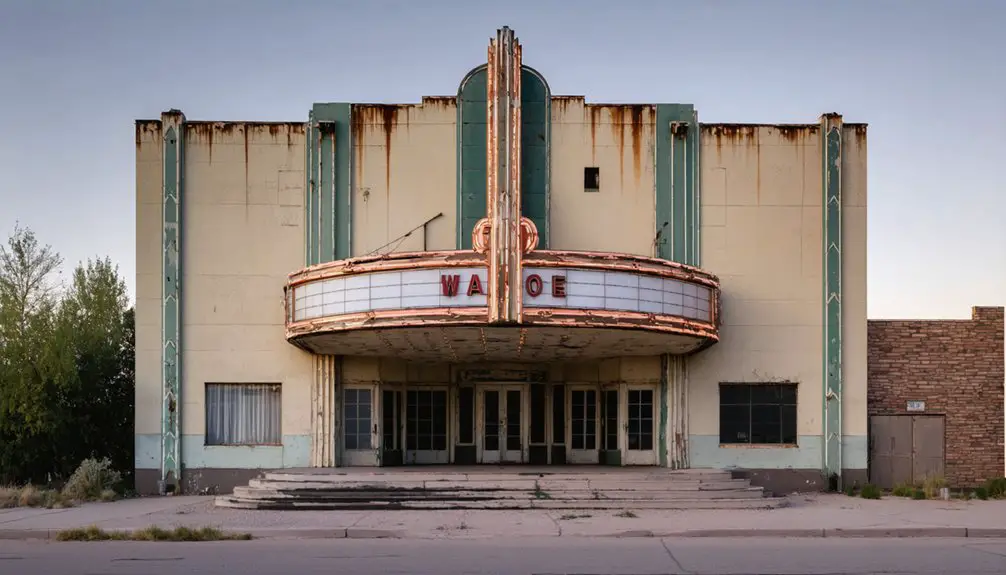
Rising majestically from the ashes of its predecessors, the Washoe Theater stands as America’s final example of Nuevo Deco theater architecture.
When you step inside, you’ll discover an artistic influence that blends French Art Nouveau with striking geometric patterns, adorned in copper, silver, and gold leaf accents.
Built between 1931 and 1936 at a cost of $200,000, the theater’s architectural preservation efforts have maintained its rare silk velvet curtains and elaborate murals.
You’ll notice the perfect acoustics that make it ideal for both films and musical performances.
While the theater has embraced modern technology, switching to digital projection in 2013, it hasn’t compromised its historic integrity.
The Washoe’s unique combination of flamboyant furnishings, domed painted ceilings, and complex relief patterns continues to transport you back to Hollywood’s golden age.
Transportation and Geographic Challenges
Situated at the foot of Montana’s Beartooth Mountains, Washoe faced significant geographic and transportation hurdles that shaped its development as a mining town.
The town’s geographic isolation meant you’d find limited transportation routes, with Highway 308 serving as the primary road connection to nearby Red Lodge and Bearcreek.
Like the historic mining town of Bannack at 5,728 feet, Washoe’s high elevation presented unique logistical challenges for transportation and development.
The Northern Pacific Railroad became Washoe’s lifeline, shipping roughly 1,200 tons of coal daily to regional markets like Anaconda and Butte.
Washoe thrived through its Northern Pacific Railroad connection, sending 1,200 tons of coal each day to Montana’s industrial hubs.
You’ll appreciate how the harsh mountain weather posed constant challenges, with snowdrifts reaching up to 20 feet and frequently closing access roads.
The railroad proved especially crucial during winter months when road travel became unreliable, though even rail operations had to adapt to the severe seasonal conditions.
Women’s Contributions to Town Culture

Beyond the physical challenges of Washoe’s mountain setting, women shaped the social fabric of this mining community through organized leadership and resilience.
You’ll find their influence most significantly in the Women’s Club, which purchased a building that served as both a meeting space and Sunday school venue, demonstrating women’s leadership in social and religious spheres.
In the wake of mining disasters that left 58 widows and 125 fatherless children, women’s networks proved essential for community resilience.
They maintained cultural traditions, supported bereaved families, and contributed to the town’s economic stability through various enterprises. Similar to the women in mining town Coloma, they established libraries and social clubs to foster education and community bonds.
Whether organizing educational activities, managing businesses, or providing essential caregiving services, women’s roles transcended traditional domestic boundaries.
Their efforts created lasting social structures that helped Washoe endure despite the harsh realities of mining life.
Present-Day Remnants and Historical Tourism
While most of Washoe’s original structures have succumbed to time, you’ll find the historic Washoe Theater still standing as the town’s most prominent landmark along Highway 308.
Listed on the National Register of Historic Places, this 1936 Art Deco masterpiece serves as a focal point for ghost town preservation efforts in the region.
You can explore Washoe’s remnants from the roadside, though private property restrictions limit direct access to many historical sites.
The area’s mining heritage lives on through historical artifact collection, with items like “WASHOE”-stamped mining tools becoming prized collectibles.
For a broader historical experience, you’ll find Washoe conveniently situated along a route featuring better-preserved ghost towns like Virginia City.
The nearby Smith Mine #3 site, though not accessible, stands as a somber reminder of Montana’s worst mining disaster.
Frequently Asked Questions
What Happened to the Mine Workers’ Families After the 1943 Disaster?
You’ll find that families faced devastating losses in the disaster aftermath, with 58 widows and 125 fatherless children forcing family relocation as they sought work elsewhere amid severe financial hardship.
Are There Any Surviving Photos of Washoe During Its Peak Years?
While you’ll find few surviving photos from Washoe’s peak years, some historical documentation exists in private collections and local museums. Ghost town photography mostly shows post-decline ruins rather than the bustling mining era.
What Was the Average Salary of Miners in Washoe?
You’d find mining wages in Washoe ranged from $3-$5 daily during the early 1900s, though the historical economy meant your real earnings were less after company store deductions and housing costs.
Can Visitors Safely Explore the Abandoned Mine Sites Today?
You shouldn’t explore these abandoned mines due to extreme dangers. Even with safety precautions, mine exploration risks deadly gas exposure, sudden collapse, and toxic contamination. Stay outside designated viewing areas.
Did Any Notable Outlaws or Historical Figures Ever Visit Washoe?
You won’t find any documented outlaw legends or historical visits from famous figures in Washoe’s history. The town’s significance stems from its mining heritage and working families, not frontier celebrities.
References
- https://digging-history.com/2013/12/11/ghost-town-wednesday-washoe-montana/
- https://www.ultimatemontana.com/region-info/red-lodge-area/washoe
- https://leisuregrouptravel.com/park-to-park-ghost-town-route/
- https://www.geowyo.com/red-lodge—bear-creek-coal.html
- https://www.ghosttowns.com/states/mt/washoe.html
- https://montanahistoriclandscape.com/tag/washoe-stack/
- https://usminedisasters.miningquiz.com/saxsewell/bearcreekmtn.htm
- https://www.mtmemory.org/nodes/view/128320
- https://archiveswest.orbiscascade.org/ark:80444/xv06169
- http://mthistoryrevealed.blogspot.com/2016/10/great-falls-and-anaconda-copper-company.html
